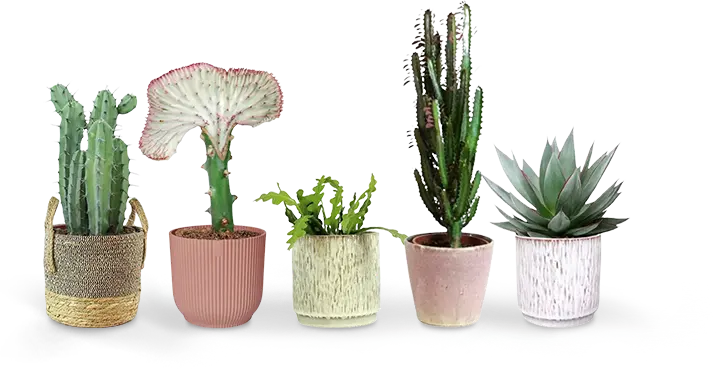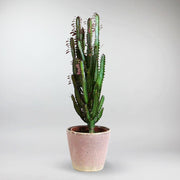Cactus Plants
Cactus Plants
Care Tips for Success
Cactus plants thrive in well-draining soil and need watering only when the soil is dry. Place them in bright, indirect light to mimic their natural habitat, and watch them flourish with minimal effort.
Perfect for Any Setting
Whether you’re looking to create a serene corner in your home or a stylish accent for your workspace, cactus plants offer unmatched versatility. Their unique forms and hardy nature make them the perfect addition to modern and minimalist décor.
Invest in a Cactus Plant today to enjoy the perfect blend of beauty, resilience, and style!
Cactus Plants FAQs
How To Look After A Cactus Plant?
Light
Cacti love to get a lot of light and - especially in the UK - they pretty much want as much as they can get. This means that putting your indoor cactus plant in a south-facing spot with lots of direct sunlight is a good idea. However, just like us humans, cactus plants can get sunburnt if they get too much sun… we’ve all been there. So, if your cactus plant starts to yellow or brown, move it out of the direct light to let it cool off a little!
Water
Cactus plants are renowned for their resilience, so they don’t need constant watering in order to survive. However, this doesn’t mean that your indoor cactus plant doesn’t need water - far from it. In fact, all types of cactus thrive from regular watering, so it’s important to check their soil every few weeks.
If the first few inches are dry, they will enjoy a good soaking of water to keep them going. It’s best to dunk cacti in water (rather than pour it on) and then properly drain them. This means that the cacti can take the water they need, but no more. You can also sit your cactus plant on a saucer filled with water to let it drink all the water it needs! Just pop it there for 5-10 minutes (depending on the size of your cactus plant), take it off the saucer, allow it to drain and then place it back in its decorative pot.
The amount of water your cacti needs will depend on the conditions it is facing. In the summer, when it gets a lot of light (even if it is indirect) it will need more watering than during the winter months. Warmer weather also means water evaporates quicker, so bear this in mind when watering your thirsty little cacti.
But, be warned! It is important you don’t overwater your cactus plant. This could cause root rot, scab, and eventually, certain death. Always make sure the first few inches of soil are dry before you re-water your plant and when in doubt, leave the water out!
Soil
Cactus love soil that is a little gritty, containing sands and rocks. This helps them to drain water more easily so the roots don’t get too soggy. They also enjoy a little fertilizer every once in a while (about twice a year). This helps make sure they have the right nutrition.
Keep an eye on it!
Like all plants, if cacti aren’t in the right conditions, they will start to show it. If your cactus starts to wilt or go yellow and squishy, it may be overwatered and you should let it dry out. If it is drying up or puckering, it may need a little more water. If your cactus plant gets pot-bound, it’s time to re-pot in a larger pot. Basically, the secret to keeping a happy cactus is checking up on it to make sure it is alright, so don’t forget about your cactus friend!
What Are Common Types Of Cacti?
-
Bunny Ears Cactus (Opuntia Microdasys)
This Mexican cactus is legendary for its cute bunny ear shape… but, don’t be fooled! This is a prickled cactus that should be handled with care. If treated right, it will flower white and purple flowers!
-
Candelabra Cactus (Euphorbia Eritrea)
From the Horn of Africa, the Candelabra Cactus stands tall, with one large central stem and, although it looks prickly and cactus-like, it actually has no long spines, just thorns, and is technically a succulent! This plant is super easy to care for, requiring very little water.
-
Fishbone Cactus (Epiphyllum Anguliger)
Named after its long wavy fishbone-shaped stems, the Fishbone Cactus is a funky spike-free cactus (although still containing fine spikes that can prick when touched) that can reach 30 cm in height and may even flower if watered enough. Native to Mexico, this cactus is low-maintenance and easy to propagate!
-
Mistletoe Cactus (Rhipsalis Cashero)
The Mistletoe Cactus (Rhipsalis Cashero) stands out from the cactus crowd. Why? Because, unlike almost all other cacti, it is thorn-free, thin, and trailing. Found in Mexico and Brazil, this cactus plant is easy to care for, and works great in a hanging pot.
-
Old Lady Cactus (Mammillaria Hahniana)
Resembling a pin cushion, the Old Lady Cactus grows in a rounded form that is covered with hairs and spikes. This Mexican cactus requires watering every few weeks, and can grow pinky, purple flowers!
How To Propagate A Cactus Plant?
Propagating plants is a great way of expanding your plant family without breaking the budget. As long as you have a cactus plant that is growing healthy with stems of at least 10 cm, you should be able to propagate it. Here’s how….
- Identify a healthy stem and cut it off with sharp scissors.
- Leave your cuttings on a windowsill until healed.
- In a new pot, plant your removed cactus stem so it stands upright, with the cut side buried in the soil.
- Soak the soil with water (avoid the main body of the plant) and place in a warm, bright spot, preferably away from direct light.
- Cover with a plastic bag or cling film.
- Monitor your cuttings and water if the soil dries out. Within a month it should root and your new cactus plant should be propagated!
Some cactus plants are easier to propagate than others. For example, one of the great benefits of a Fishbone Cactus is how easy it is to propagate.
What’s The Best Spot In The Home To Place A Cactus?
Cacti enjoy a lot of light, so it is best to place them in a spot where they get it. Next to a south-facing window is the ultimate spot for your cactus, although make sure to move them if they are getting too much direct sunlight and showing signs of sunburn. Normally cacti don’t thrive in the bathroom, as it is too humid, but, aside from that, you can pretty much place your cactus anywhere you think it looks best!
Do Cactus Plants Flower?
All types of cactus have the potential to flower, however, for some indoor cactus plants, this is rare. Indoor cactus plants have to be grown in exactly the right conditions to flower, and even then it can take from 1-10 years for them to bloom. In fact, for some types of cactus, it can take up to 50 years! So, if you want to see some cactus flowers, make sure to pick a plant that flowers more easily, like a dwarf cactus!
Are cactus plants dangerous for pets?
If you have adventurous pets, having a spiky indoor cactus plant may lead to the odd thorn in a paw. However, this is an issue that can be easily resolved by positioning your cactus in a spot out of reach of your furry friends, or in a room they aren’t allowed to go in. Don’t worry though, almost all cactus plants are not poisonous to humans or pets, so if they do get accidentally eaten, you will see some nasty side effects, but it won’t be fatal.




















